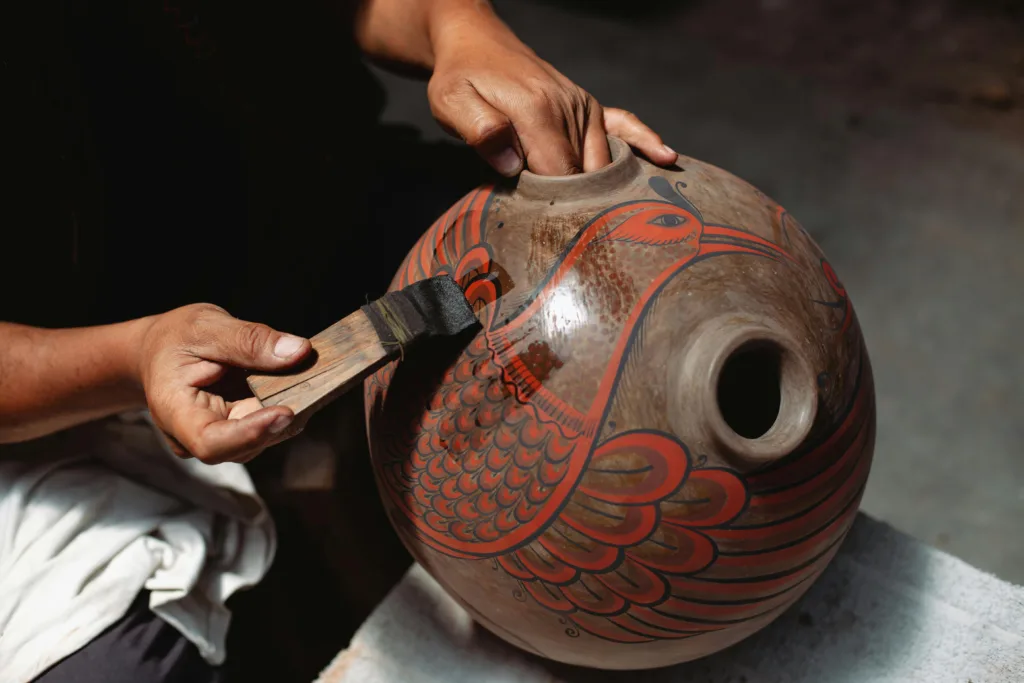Selling handmade crafts can be a fulfilling and lucrative side hustle for those who enjoy creating unique items and want to share their creativity with others.
With the rise of online marketplaces and the growing demand for personalized and artisanal products, there’s never been a better time to turn your crafting hobby into a profitable venture.
Let’s explore how to get started, potential earnings, essential skills, and the pros and cons of selling handmade crafts as a side hustle.
How Do You Get Started with Selling Handmade Crafts?
Starting a handmade craft business involves several key steps. Here’s how to begin:
1. Identify Your Niche
Focus on a specific type of craft that you enjoy and excel at. Popular niches include jewelry, home decor, clothing and accessories, stationery, candles, and bath products. A well-defined niche helps you stand out in a crowded market and attract a targeted audience.
2. Develop Your Products
Create a range of products that showcase your skills and creativity. Ensure that your items are well-made, unique, and appealing to your target market. Pay attention to quality and detail, as handmade buyers often seek high-quality, artisanal goods.
3. Source Materials
Find reliable suppliers for the materials you need. Look for quality materials at reasonable prices to maintain a balance between cost and quality. Buying in bulk can save money and ensure you have a consistent supply.
4. Set Up an Online Store
Set up an online store to showcase and sell your crafts. Popular platforms for selling handmade items include Etsy, Shopify, and Amazon Handmade. These platforms offer user-friendly interfaces, large customer bases, and tools to help you manage your business.
5. Price Your Products
Determine your pricing strategy by considering the cost of materials, labor, and overhead, as well as your desired profit margin. Research competitors’ prices to ensure your products are competitively priced while still covering your costs and making a profit.
6. Promote Your Business
Promote your handmade crafts through social media, online marketplaces, craft fairs, and local markets. Use high-quality photos and engaging descriptions to attract customers. Networking with other crafters and participating in online communities can also help increase your visibility.
How Much Can You Earn Selling Handmade Crafts?
Earnings from selling handmade crafts can vary widely based on the type of products, pricing, and your sales channels. Here’s a general breakdown:
1. Beginner Crafters
As a beginner, you might earn a modest income while building your brand and customer base. Earnings can range from $50 to $500 per month, depending on the popularity of your products and your marketing efforts.
2. Intermediate Crafters
With a growing customer base and a well-established brand, intermediate crafters can earn between $500 and $2,000 per month. This stage often involves diversifying your product line and expanding your reach through various sales channels.
3. Experienced Crafters
Experienced crafters with a loyal following and a strong online presence can earn $2,000 to $10,000 or more per month. Successful crafters often have multiple income streams, such as wholesale orders, custom commissions, and teaching workshops.
4. Top Crafters
Top crafters in highly sought-after niches can earn six figures annually. These crafters typically have a significant online presence, collaborate with brands, and sell high-value items or offer exclusive products.
What Skills Do You Need to Succeed in Selling Handmade Crafts?
Successful handmade craft businesses require a mix of creative and business skills. Here are some key competencies you’ll need:
1. Craftsmanship
High-quality craftsmanship is essential for creating appealing and durable products. Pay attention to detail and continually refine your skills to produce the best possible items.
2. Creativity
Creativity helps you design unique and attractive products that stand out in the market. Stay inspired by exploring new techniques, materials, and design trends.
3. Business Acumen
Running a handmade craft business involves managing finances, pricing products, and handling logistics. Basic business skills, such as budgeting, bookkeeping, and marketing, are crucial for success.
4. Marketing Skills
Promoting your crafts effectively is key to attracting customers and growing your business. Learn how to use social media, email marketing, and SEO to reach a wider audience and drive sales.
5. Customer Service
Providing excellent customer service helps build a loyal customer base and generates positive word-of-mouth. Respond to inquiries promptly, handle issues professionally, and go the extra mile to ensure customer satisfaction.
6. Time Management
Balancing crafting with other responsibilities requires good time management skills. Plan your production schedule, set realistic goals, and prioritize tasks to stay organized and efficient.
What Are the Pros and Cons of Selling Handmade Crafts as a Side Hustle?
Every side hustle has its benefits and challenges. Here’s what you can expect from selling handmade crafts:
Pros
- Creative Outlet: Selling handmade crafts allows you to express your creativity and share your passion with others.
- Flexibility: You can work from home and set your own schedule, making it a flexible side hustle.
- Low Startup Costs: Starting a handmade craft business typically requires a minimal initial investment for materials and supplies.
- Personal Fulfillment: Creating and selling your own products can be highly rewarding and satisfying.
- Scalability: As your business grows, you can expand your product line, increase production, and explore new sales channels.
Cons
- Time-Consuming: Creating handmade items can be time-consuming, especially when balancing other commitments.
- Variable Income: Earnings can be inconsistent, particularly when starting out or during slow sales periods.
- Competition: The handmade market is competitive, requiring continuous effort to stand out and attract customers.
- Physical Demands: Crafting can be physically demanding, depending on the type of products you make.
- Business Challenges: Managing the business side of things, such as finances, marketing, and customer service, can be challenging and require additional skills.
FAQs About Selling Handmade Crafts as a Side Hustle
1. Do I need any special licenses or permits to sell handmade crafts?
Depending on your location and the type of products you sell, you may need certain licenses or permits. Check with your local government or small business association to determine the requirements in your area.
2. How can I improve my crafting skills?
Practice regularly, experiment with new techniques, and seek feedback from other crafters and customers. Taking classes or workshops, either online or in person, can also help you improve your skills and stay inspired.
3. Can I sell my crafts on multiple platforms?
Yes, selling on multiple platforms can help you reach a broader audience. Manage your inventory carefully to avoid overselling and ensure consistent quality across all sales channels.
4. How do I price my handmade crafts?
Consider the cost of materials, labor, and overhead when pricing your products. Research competitors’ prices and factor in your desired profit margin. Remember to account for platform fees and shipping costs if selling online.
5. What if my products don’t sell well?
If your products aren’t selling well, consider reevaluating your pricing, marketing strategies, and product offerings. Seek feedback from customers to understand their preferences and make necessary adjustments.
6. How can I promote my handmade crafts effectively?
Utilize social media platforms to showcase your products and engage with potential customers. Use high-quality photos and compelling descriptions to attract attention. Participate in craft fairs, markets, and online communities to increase your visibility.






